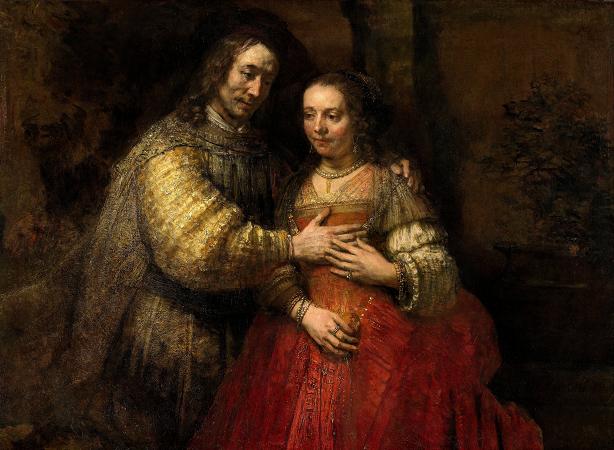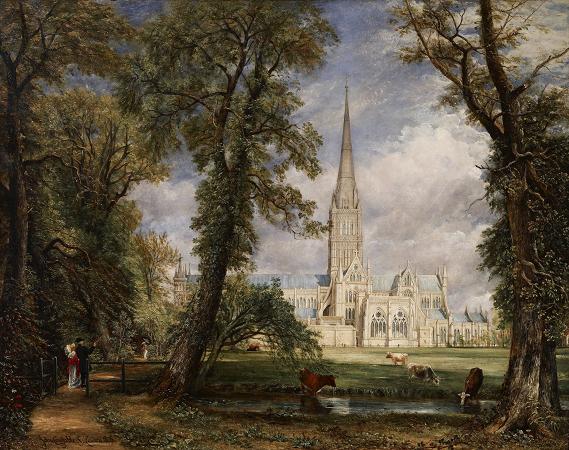Night Watch (1642). Oil on canvas. 122 x 167. Militia Company of District II under the Command of Captain Frans Banninck Cocq, also known as The Shooting Company of Frans Banning Cocq and Willem van Ruytenburch, but commonly referred to as The Night Watch, is a 1642 painting by Rembrandt van Rijn. It is in the collection of the Amsterdam Museum but is prominently displayed in the Rijksmuseum as the best-known painting in its collection. The Night Watch is one of the most famous Dutch Golden Age paintings. The painting is famous for three things: its colossal size, the dramatic use of light and shadow and the perception of motion in what would have traditionally been a static military group portrait. The painting was completed in 1642, at the peak of the Dutch Golden Age. It depicts the eponymous company moving out, led by Captain Frans Banninck Cocq and his lieutenant, Willem van Ruytenburch. With effective use of sunlight and shade, Rembrandt leads the eye to the three most important characters among the crowd: the two men in the center, and the woman in the centre-left background carrying a chicken. Behind them, the company's colors are carried by the ensign, Jan Visscher Cornelissen. The figures are almost life-size. Rembrandt has displayed the traditional emblem of the arquebusiers in a natural way, with the woman in the background carrying the main symbols. She is a kind of mascot herself; the claws of a dead chicken on her belt represent the clauweniers, the pistol behind the chicken represents clover and she is holding the militia's goblet. The man in front of her is wearing a helmet with an oak leaf, a traditional motif of the arquebusiers. The dead chicken is also meant to represent a defeated adversary. The colour yellow is often associated with victory. In July 2019 a long and complex restoration began. The restoration is taking place in public, in a specially-made glass enclosure built and placed in the Rijksmuseum, and is being livestreamed. The plan was to move the 337kg painting into it starting when the museum closed for the day on 9 July, then to map the painting layer by layer and pigment by pigment, and plan conservation work according to what was found. As the painting has always been on display, even those who knew it best had much to learn. Taco Dibbits, the Rijksmuseum's general director, said that despite working there for 17 years he had never seen the top of the painting; We know so little on how he worked on making The Night Watch. For much of its existence, the painting was coated with a dark varnish, which gave the incorrect impression that it depicted a night scene, leading to the name by which it is now commonly known. This varnish was removed only in the 1940s. In 1715, upon its removal from the Kloveniersdoelen to the Amsterdam Town Hall, the painting was trimmed on all four sides. This was done, presumably, to fit the painting between two columns and was a common practice before the 19th century. This alteration resulted in the loss of two characters on the left side of the painting, the top of the arch, the balustrade, and the edge of the step. This balustrade and step were key visual tools used by Rembrandt to give the painting a forward motion. A 17th-century copy of the painting by Gerrit Lundens at the National Gallery, London shows the original composition. The painting was commissioned by Captain Banning Cocq and seventeen members of his Kloveniers. Eighteen names appear on a shield, painted circa 1715, in the center-right background, as the hired drummer was added to the painting for free. A total of 34 characters appear in the painting. Rembrandt was paid 1,600 guilders for the painting, a large sum at the time. This was one of a series of seven similar paintings of the militiamen commissioned during that time from various artists. The painting was commissioned to hang in the banquet hall of the newly built Kloveniersdoelen in Amsterdam. Some have suggested that the occasion for Rembrandt's commission and the series of other commissions given to other artists was the visit of the French queen, Marie de Medici, in 1638. Even though she was escaping from her exile from France ordered by her son Louis XIII, the queen's arrival was met with great pageantry. There is some academic discussion as to where Rembrandt actually executed the painting. It is too large to have been completed in his studio in his house. Scholars are divided. In city records of the period, he applied to build a summer kitchen on the back of his house. The dimensions of this structure would have accommodated the painting over the three years it took him to paint it. Another candidate is in an adjacent church and a third possibility is actually on site. The Night Watch first hung in the Groote Zaal or Amsterdam's Kloveniersdoelen.
more...




